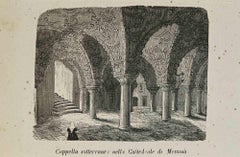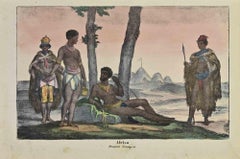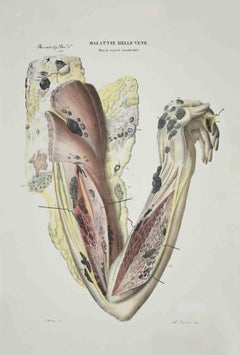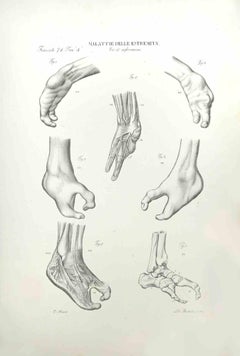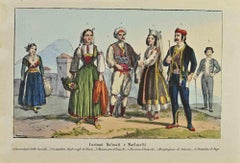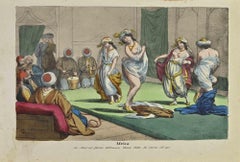1840s Art
to
35
607
293
45
18
14
Overall Width
to
Overall Height
to
7,476
21,066
160,116
233,353
1,940
2,227
4,770
6,398
5,824
14,946
20,284
25,512
17,786
13,653
5,305
702
13
7
1
1
621
347
4
641
290
242
194
132
127
101
93
84
62
61
48
43
40
31
31
27
27
24
24
670
128
114
78
63
40
38
27
15
8
123
707
744
145
Period: 1840s
Sotteraneo Chapel in Messina Cathedral - Lithograph - 1862
Located in Roma, IT
Underground Chapel in Messina Cathedral is a lithograph realized in 1862.
Good conditions.
The artwork belongs to the Suite Uses and customs of all the peoples of the universe, or ...
Category
Modern 1840s Art
Materials
Lithograph
Ancient African Customs - Lithograph by Auguste Wahlen - 1844
Located in Roma, IT
Ancient African Customs is a lithograph realized by Auguste Wahlen in 1844.
Hand colored.
Good condition.
At the center of the artwork is the original title "Africa" and subtitle ...
Category
Modern 1840s Art
Materials
Lithograph
Vein Diseases - Lithograph By Ottavio Muzzi - 1843
Located in Roma, IT
Vein Diseases is a lithograph hand colored by Ottavio Muzzi for the edition of Antoine Chazal,Human Anatomy, Printers Batelli and Ridolfi, realized in 1843.
Signed on plate on the l...
Category
Modern 1840s Art
Materials
Lithograph
Extremity Diseases - Lithograph By Ottavio Muzzi - 1843
Located in Roma, IT
Extremity Diseases is a lithograph hand colored by Ottavio Muzzi for the edition of Antoine Chazal,Human Anatomy, Printers Batelli and Ridolfi, realized in 1843.
Signed on plate on ...
Category
Modern 1840s Art
Materials
Lithograph
Dalmatian and Morlacchi Customs - Lithograph by Auguste Wahlen - 1844
Located in Roma, IT
Dalmatian and Morlacchi Customs is a lithograph made by Auguste Wahlen in 1844.
Hand colored.
Good condition.
At the center of the artwork is the original title "Costumi Dalmati e...
Category
Modern 1840s Art
Materials
Lithograph
Ancient African Costumes - Lithograph by Auguste Wahlen - 1844
Located in Roma, IT
Ancient African Costumes is a lithograph made by Auguste Wahlen in 1844.
Hand colored.
Good condition.
At the center of the artwork is the original title "Africa" and subtitle "Le...
Category
Modern 1840s Art
Materials
Lithograph
Pier in Algiers - Lithograph by Auguste Wahlen - 1844
Located in Roma, IT
Pier in Algiers is a lithograph made by Auguste Wahlen in 1844.
Good condition.
At the center of the artwork is the original title "Molo di Algeri".
The work is part of Suite Moeu...
Category
Modern 1840s Art
Materials
Lithograph
Diseases of the Intestines - Lithograph By Ottavio Muzzi - 1843
Located in Roma, IT
Diseases of the Intestines is a lithograph hand colored by Ottavio Muzzi for the edition of Antoine Chazal,Human Anatomy, Printers Batelli and Ridolfi, realized in 1843.
Signed on p...
Category
Modern 1840s Art
Materials
Lithograph
Ancient African Customs - Lithograph by Auguste Wahlen - 1844
Located in Roma, IT
Ancient African Customs is a lithograph made by Auguste Wahlen in 1844.
Hand colored.
Good condition.
At the center of the artwork is the original title "Africa" and subtitle "Fun...
Category
Modern 1840s Art
Materials
Lithograph
Pelican - Etching by Johann Friedrich Naumann - 1840
Located in Roma, IT
Pelican is an Etching hand colored realized by Gotthilf Heinrich von Schubert - Johann Friedrich Naumann, Illustration from Natural history of birds in pictures, published by Stuttga...
Category
Contemporary 1840s Art
Materials
Etching
Types of Kamchatdales - Lithograph by Auguste Wahlen - 1844
Located in Roma, IT
Types of Kamchatdales is a lithograph made by Auguste Wahlen in 1844.
Hand colored.
Good condition.
At the center of the artwork is the original title "Types des Kamtchadales".
T...
Category
Modern 1840s Art
Materials
Lithograph
Diseases of the Intestines - Lithograph By Ottavio Muzzi - 1843
Located in Roma, IT
Diseases of the Intestines is a lithograph hand colored by Ottavio Muzzi for the edition of Antoine Chazal,Human Anatomy, Printers Batelli and Ridolfi, realized in 1843.
Signed on ...
Category
Modern 1840s Art
Materials
Lithograph
Siamese - Lithograph by Auguste Wahlen - 1844
Located in Roma, IT
Siamese is a lithograph made by Auguste Wahlen in 1844.
Hand colored.
Good condition.
At the center of the artwork is the original title "Siamese".
The work is part of Suite Moeu...
Category
Modern 1840s Art
Materials
Lithograph
Eagle - Etching by Johann Friedrich Naumann - 1840
Located in Roma, IT
Eagle is an etching hand colored realized by Gotthilf Heinrich von Schubert - Johann Friedrich Naumann, Illustration from Natural history of b...
Category
Modern 1840s Art
Materials
Etching
Tartar Family Katschcntzes - Lithograph by Auguste Wahlen - 1844
Located in Roma, IT
Tartar Family Katschcntzes is a lithograph made by Auguste Wahlen in 1844.
Hand colored.
Good condition.
At the center of the artwork is the original title "Famille Tartare Katsch...
Category
Modern 1840s Art
Materials
Lithograph
Maccabei Tomb - Lithograph - 1862
Located in Roma, IT
Maccabei Tomb is a lithograph realized in 1864.
Good conditions.
The artwork belongs to the Suite Uses and customs of all the peoples of the universe, or History of the government...
Category
Modern 1840s Art
Materials
Lithograph
Breast Diseases - Lithograph By Ottavio Muzzi - 1843
Located in Roma, IT
Breast Diseases is a lithograph hand colored by Ottavio Muzzi for the edition of Antoine Chazal,Human Anatomy, Printers Batelli and Ridolfi, realized in 1843.
Signed on plate on the...
Category
Modern 1840s Art
Materials
Lithograph
Parrots - Etching by Johann Friedrich Naumann - 1840
Located in Roma, IT
Parrots is an Etching hand colored realized by Gotthilf Heinrich von Schubert - Johann Friedrich Naumann, Illustration from Natural history of birds in pictures, published by Stuttga...
Category
Modern 1840s Art
Materials
Etching
Royal Palace in Isfahan - Lithograph - 1862
Located in Roma, IT
Royal palace in Isfahan is a lithograph realized in 1864.
Good conditions.
The artwork belongs to the Suite Uses and customs of all the peoples of the universe, or History of the ...
Category
Modern 1840s Art
Materials
Lithograph
Yakut - Lithograph by Auguste Wahlen - 1844
Located in Roma, IT
Yakut is a lithograph made by Auguste Wahlen in 1844.
Hand colored.
Good condition.
At the center of the artwork is the original title "Yakute".
The work is part of Suite Moeurs,...
Category
Modern 1840s Art
Materials
Lithograph
Brain Diseases - Lithograph By Ottavio Muzzi - 1843
Located in Roma, IT
Brain Diseases is a lithograph hand colored by Ottavio Muzzi for the edition of Antoine Chazal,Human Anatomy, Printers Batelli and Ridolfi, realized in 1843.
Signed on plate on the l...
Category
Modern 1840s Art
Materials
Lithograph
Cathedral in Palermo - Lithograph - 1862
Located in Roma, IT
Cathedral in Palermo is a lithograph realized in 1862.
Good condition.
The artwork belongs to the Suite Uses and customs of all the peoples of the universe, or History of the gov...
Category
Modern 1840s Art
Materials
Lithograph
Mardin Turk - Lithograph by Auguste Wahlen - 1844
Located in Roma, IT
Mardin Turk is a lithograph made by Auguste Wahlen in 1844.
Hand colored.
Good condition.
At the center of the artwork is the original title "Turc de Mardin".
The work is part of...
Category
Modern 1840s Art
Materials
Lithograph
Cavalry - China Ink and Watercolor by Theodore Fort - 1844 ca.
Located in Roma, IT
Cavalry is a beautiful watercolor on paper, realized in the mid-XIX century by Théodore Géricaul Fort (1810 - 1896).
Hand-signed in brown ink on the lower right corner.
A knight is portrayed in his uniform and galloping on a beautiful Arabian stallion, with the trumpet on his shoulders, ready to give the signal to attack to the cavalry.
In excellent conditions, with shiny colors, including a white cardboard passepartout (49.5 x 34 cm).
A very interesting artwork for a connoisseur of the militaria genre!
Theodore Géricaul Fort (1810 - 1896), Simeone Fort's son, belonged to the French school of the XIX century; Théodore Fort...
Category
Modern 1840s Art
Materials
Watercolor
Diseases of the Lymphatic Vessels - Lithograph By Ottavio Muzzi - 1843
Located in Roma, IT
Diseases of the Lymphatic Vessels is a lithograph hand colored by Ottavio Muzzi for the edition of Antoine Chazal, Human Anatomy, Printers Batelli and Ridolfi, 1843.
The work belong...
Category
Modern 1840s Art
Materials
Lithograph
Japanese Lady - Lithograph by Auguste Wahlen - 1844
Located in Roma, IT
Japanese Lady is a lithograph made by Auguste Wahlen in 1844.
Hand colored.
Good condition.
At the center of the artwork is the original title "Dame Japonaise".
The work is part ...
Category
Modern 1840s Art
Materials
Lithograph
Eleuthe - Lithograph by Auguste Wahlen - 1844
Located in Roma, IT
Eleuthe is a lithograph made by Auguste Wahlen in 1844.
Hand colored.
Good condition.
At the center of the artwork is the original title "Eleuthe".
The work is part of Suite Moeu...
Category
Modern 1840s Art
Materials
Lithograph
Fonte Canapina - Original Etching by Luigi Bartolini - 1940
Located in Roma, IT
Image dimensions: 12.5 x 19.5 cm.
Fonte Canapina (Canapina Fount) is an original work realized by Luigi Bartolini in 1940.
Original etching on China paper applied.
Hand-signed in ...
Category
1840s Art
Materials
Etching
Small Intestine Disease - Lithograph By Ottavio Muzzi - 1843
Located in Roma, IT
Small Intestine Disease is a lithograph hand colored by Ottavio Muzzi for the edition of Antoine Chazal, Human Anatomy, Printers Batelli and Ridolfi, 1843.
The work belongs to the A...
Category
Modern 1840s Art
Materials
Lithograph
Jeune Fille de Timboucrou - Lithograph by Auguste Wahlen - 1844
Located in Roma, IT
Jeune Fille de Timboucrou is a hand colored lithographs realized by Auguste Wahlen in 1844.
Good conditions.
The artwork belongs to the Suite Moeurs, usages et costumes de tous les...
Category
Modern 1840s Art
Materials
Lithograph
Geremia Tomb - Lithograph - 1862
Located in Roma, IT
Geremia Tomb is a lithograph realized in 1864.
Good conditions.
The artwork belongs to the Suite Uses and customs of all the peoples of the universe, or History of the government,...
Category
Modern 1840s Art
Materials
Lithograph
Messina Cathedral Square - Lithograph - 1862
Located in Roma, IT
Messina Cathedral Square is a lithograph realized in 1862.
Good conditions.
The artwork belongs to the Suite Uses and customs of all the peoples of the universe, or History of the ...
Category
Modern 1840s Art
Materials
Lithograph
The Alcazar in Toledo - Lithograph - 1862
Located in Roma, IT
The Alcazar in Toledo is a lithograph realized in 1864.
Good conditions.
The artwork belongs to the Suite Uses and customs of all the peoples of the universe, or History of the gov...
Category
Modern 1840s Art
Materials
Lithograph
Stomach Diseases - Lithograph By Ottavio Muzzi - 1843
Located in Roma, IT
Stomach Diseases is a lithograph hand colored by Ottavio Muzzi for the edition of Antoine Chazal, Human Anatomy, Printers Batelli and Ridolfi, 1843.
The...
Category
Modern 1840s Art
Materials
Lithograph
Indiens Corbeaux - Lithograph by Auguste Wahlen - 1844
Located in Roma, IT
Indiens Corbeaux is a hand colored lithographs realized by Auguste Wahlen in 1844.
Good conditions.
The artwork belongs to the Suite Moeurs, usages et costumes de tous les peuples ...
Category
Modern 1840s Art
Materials
Lithograph
Barcelona - Lithograph - 1862
Located in Roma, IT
Barcelona is a lithograph realized in 1864.
Good conditions.
The artwork belongs to the Suite Uses and customs of all the peoples of the universe, or Hi...
Category
Modern 1840s Art
Materials
Lithograph
Hunting in North Africa - Lithograph - 1848 ca.
Located in Roma, IT
The Hunting is an original hand-colored lithograph on paper realized in 1848 ca. by an Anonymous artist of the mid-XIX century.
Titled on the lower center in Italian" Una Caccia.
I...
Category
1840s Art
Materials
Lithograph
Tomb of Naksci-Rustam - Lithograph - 1862
Located in Roma, IT
Tomb of Naksci-Rustam is a lithograph realized in 1864.
Good conditions.
The artwork belongs to the Suite Uses and customs of all the peoples of the universe, or History of the go...
Category
Modern 1840s Art
Materials
Lithograph
Reine des l'Isles Sandwich - Lithograph by Auguste Wahlen - 1844
Located in Roma, IT
Reine des i'Les Sandwich is a hand colored lithograph realized by Auguste Wahlen in 1844.
Good conditions.
The artwork belongs to the Suite Moeurs, usages et costumes de tous les p...
Category
Modern 1840s Art
Materials
Lithograph
Naturel de l'Ile Rotti - Lithograph by Auguste Wahlen - 1844
Located in Roma, IT
Naturel de l'Ile Rotti is a hand colored lithograph realized by Auguste Wahlen in 1844.
Good conditions.
The artwork belongs to the Suite Moeurs, usages et costumes de tous les peu...
Category
Modern 1840s Art
Materials
Lithograph
Court of the Audience Hall of the Imperial Palace in Beijing - Lithograph - 1862
Located in Roma, IT
Court of the Audience Hall of the Imperial Palace in Beijing is a lithograph realized in 1864.
Good conditions.
The artwork belongs to the Suite Uses and customs of all the peoples...
Category
Modern 1840s Art
Materials
Lithograph
Botanical Garden in Brussels - Lithograph - 1862
Located in Roma, IT
Botanical Garden in Brussels is a lithograph realized in 1864.
Good conditions.
The artwork belongs to the Suite Uses and customs of all the peoples of the universe, or History of...
Category
Modern 1840s Art
Materials
Lithograph
Indienne de Quito - Lithograph by Auguste Wahlen - 1844
Located in Roma, IT
Indienne de Quito is a hand colored lithographs realized by Auguste Wahlen in 1844.
Good conditions.
The artwork belongs to the Suite Moeurs, usages et costumes de tous les peuples...
Category
Modern 1840s Art
Materials
Lithograph
Brain Diseases - Lithograph By Ottavio Muzzi - 1843
Located in Roma, IT
Brain Diseases is a lithograph hand colored by Ottavio Muzzi for the edition of Antoine Chazal, Human Anatomy, Printers Batelli and Ridolfi, realized in 1843.
Signed on plate on the...
Category
Modern 1840s Art
Materials
Lithograph
Bone Diseases - Lithograph By Ottavio Muzzi - 1843
Located in Roma, IT
Bone Diseases is a lithograph hand colored by Ottavio Muzzi for the edition of Antoine Chazal,Human Anatomy, Printers Batelli and Ridolfi, realized in 1843.
Signed on plate on the lo...
Category
Modern 1840s Art
Materials
Lithograph
Cloister of Monreale - Lithograph - 1862
Located in Roma, IT
Cloister of Monreale a lithograph realized in 1862.
Good conditions.
The artwork belongs to the Suite Uses and customs of all the peoples of the universe, or History of the governm...
Category
Modern 1840s Art
Materials
Lithograph
Atelier Patria - Lithograph - 1920s
Located in Roma, IT
Atelier Patria is an artwork realized by company brand Pouchoir, 1920s.
Logo PATRIA in the main sheet.
Lithograph and watercolour.
8,5 x 8,5 cm.
Good condtions
Category
Modern 1840s Art
Materials
Lithograph
Brain Diseases - Lithograph By Ottavio Muzzi - 1843
Located in Roma, IT
Brain Diseases is a lithograph hand colored by Ottavio Muzzi for the edition of Antoine Chazal, Human Anatomy, Printers Batelli and Ridolfi, 1843.
The work belongs to the Atlante ge...
Category
Modern 1840s Art
Materials
Lithograph
Chilien - Lithograph by Auguste Wahlen - 1844
Located in Roma, IT
Chilien is a hand colored lithographs realized by Auguste Wahlen in 1844.
Good conditions.
The artwork belongs to the Suite Moeurs, usages et costumes...
Category
Modern 1840s Art
Materials
Lithograph
Diseases of the Liver, Spleen and Epiploon - Lithograph By Ottavio Muzzi - 1843
Located in Roma, IT
Diseases of the Liver, Spleen and Epiploon is a lithograph hand colored by Ottavio Muzzi for the edition of Antoine Chazal, Human Anatomy, Printers Batelli and Ridolfi, 1843.
The wo...
Category
Modern 1840s Art
Materials
Lithograph
Antwerp Stock Exchange - Lithograph - 1862
Located in Roma, IT
Antwerp Stock Exchange is a lithograph realized in 1864.
Good conditions.
The artwork belongs to the Suite Uses and customs of all the peoples of the universe, or History of the g...
Category
Modern 1840s Art
Materials
Lithograph
Danseuse a Java - Lithograph by Auguste Wahlen - 1844
Located in Roma, IT
Danseuse a Java is a hand colored lithographs realized by Auguste Wahlen in 1844.
Good condition.
The artwork belongs to the Suite Moeurs, usages et costumes de tous les peuples du...
Category
Modern 1840s Art
Materials
Lithograph
The City Palace in Brussels - Lithograph - 1862
Located in Roma, IT
The City Palace in Brussels is a lithograph realized in 1864.
Good conditions.
The artwork belongs to the Suite Uses and customs of all the peoples of the universe, or History of t...
Category
Modern 1840s Art
Materials
Lithograph
Naturel du Detroit Princesse Marianne - Lithograph by Auguste Wahlen - 1844
Located in Roma, IT
Naturel du Detroit Princesse Marianne is a hand colored lithograph realized by Auguste Wahlen in 1844.
Good conditions.
The artwork belongs to the Suite Moeurs, usages et costumes ...
Category
Modern 1840s Art
Materials
Lithograph
Maxourounas - Lithograph by Auguste Wahlen - 1844
Located in Roma, IT
Maxourounas is a hand colored lithographs realized by Auguste Wahlen in 1844.
Good conditions.
The artwork belongs to the Suite Moeurs, usages et cost...
Category
Modern 1840s Art
Materials
Lithograph
House in Ghent where Charles V was born - Lithograph - 1862
Located in Roma, IT
House in Ghent where Charles V was born is a lithograph realized in 1864.
Good conditions.
The artwork belongs to the Suite Uses and customs of all the peoples of the universe, or ...
Category
Modern 1840s Art
Materials
Lithograph
Femmes de l'ile des Kanguroos - Lithograph by Auguste Wahlen - 1844
Located in Roma, IT
Femmes de l'ile des Kanguroos is a hand colored lithographs realized by Auguste Wahlen in 1844.
Good conditions.
The artwork belongs to the Suite Moeurs, usages et costumes de tous...
Category
Modern 1840s Art
Materials
Lithograph
Bowel Diseases - Lithograph By Ottavio Muzzi - 1843
Located in Roma, IT
Bowel Diseases is a lithograph hand colored by Ottavio Muzzi for the edition of Antoine Chazal, Human Anatomy, Printers Batelli and Ridolfi, realized in 1843.
Signed on plate on the ...
Category
Modern 1840s Art
Materials
Lithograph
DamsBreaking in the Netherlands - Lithograph - 1862
Located in Roma, IT
Dams breaking in the Netherlands is a lithograph realized in 1864.
Good conditions.
The artwork belongs to the Suite Uses and customs of all the peoples of the universe, or History...
Category
Modern 1840s Art
Materials
Lithograph
Liver Diseases - Lithograph By Ottavio Muzzi - 1843
Located in Roma, IT
Liver Diseases is a lithograph hand colored by Ottavio Muzzi for the edition of Antoine Chazal,Human Anatomy, Printers Batelli and Ridolfi, realized in 1843.
Signed on plate on the l...
Category
Modern 1840s Art
Materials
Lithograph
